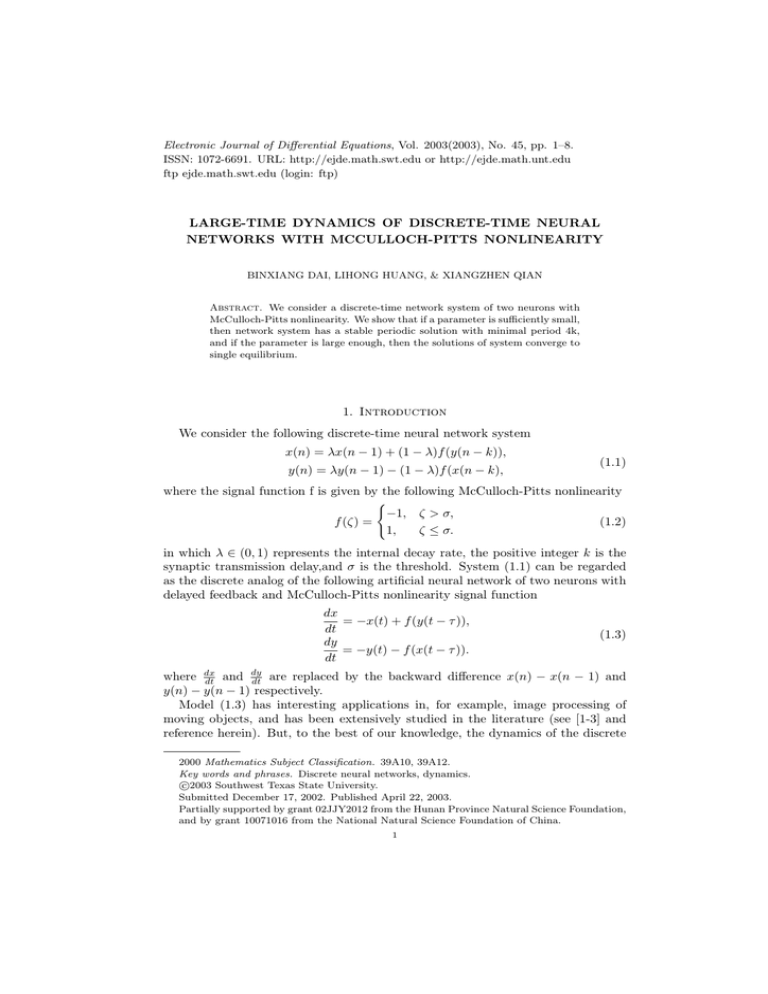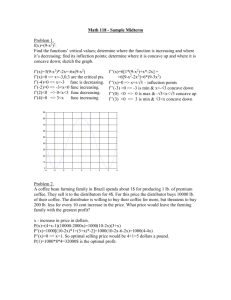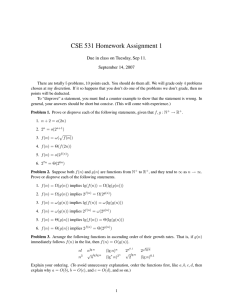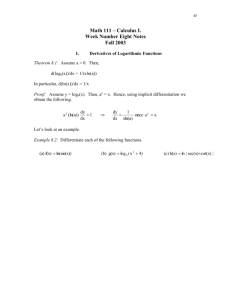Electronic Journal of Differential Equations, Vol. 2003(2003), No. 45, pp.... ISSN: 1072-6691. URL: or
advertisement

Electronic Journal of Differential Equations, Vol. 2003(2003), No. 45, pp. 1–8.
ISSN: 1072-6691. URL: http://ejde.math.swt.edu or http://ejde.math.unt.edu
ftp ejde.math.swt.edu (login: ftp)
LARGE-TIME DYNAMICS OF DISCRETE-TIME NEURAL
NETWORKS WITH MCCULLOCH-PITTS NONLINEARITY
BINXIANG DAI, LIHONG HUANG, & XIANGZHEN QIAN
Abstract. We consider a discrete-time network system of two neurons with
McCulloch-Pitts nonlinearity. We show that if a parameter is sufficiently small,
then network system has a stable periodic solution with minimal period 4k,
and if the parameter is large enough, then the solutions of system converge to
single equilibrium.
1. Introduction
We consider the following discrete-time neural network system
x(n) = λx(n − 1) + (1 − λ)f (y(n − k)),
y(n) = λy(n − 1) − (1 − λ)f (x(n − k),
(1.1)
where the signal function f is given by the following McCulloch-Pitts nonlinearity
(
−1, ζ > σ,
f (ζ) =
(1.2)
1,
ζ ≤ σ.
in which λ ∈ (0, 1) represents the internal decay rate, the positive integer k is the
synaptic transmission delay,and σ is the threshold. System (1.1) can be regarded
as the discrete analog of the following artificial neural network of two neurons with
delayed feedback and McCulloch-Pitts nonlinearity signal function
dx
= −x(t) + f (y(t − τ )),
dt
dy
= −y(t) − f (x(t − τ )).
dt
(1.3)
dy
where dx
dt and dt are replaced by the backward difference x(n) − x(n − 1) and
y(n) − y(n − 1) respectively.
Model (1.3) has interesting applications in, for example, image processing of
moving objects, and has been extensively studied in the literature (see [1-3] and
reference herein). But, to the best of our knowledge, the dynamics of the discrete
2000 Mathematics Subject Classification. 39A10, 39A12.
Key words and phrases. Discrete neural networks, dynamics.
c
2003
Southwest Texas State University.
Submitted December 17, 2002. Published April 22, 2003.
Partially supported by grant 02JJY2012 from the Hunan Province Natural Science Foundation,
and by grant 10071016 from the National Natural Science Foundation of China.
1
2
BINXIANG DAI, LIHONG HUANG, & XIANGZHEN QIAN
EJDE–2003/45
model (1.1) are less studied (see [4,5] ).For other discrete neural networks, we refer
to [6,7].
For the sake of convenience, let Z denote the set of all integers. For any a, b ∈ Z,
a ≤ b define N (a) = {a, a + 1, · · · }, N (a, b) = {a, a + 1, · · · , b},and N = N (0). Also,
let X = {φ|φ = (ϕ, ψ) : N (−k, −1) → R2 }. For the given σ ∈ R, let
Rσ+ = {ϕ | ϕ : N (−k, −1) → R and ϕ(i) − σ > 0, for i ∈ N (−k, −1)},
Rσ− = {ϕ | ϕ : N (−k, −1) → R and ϕ(i) − σ ≤ 0, for i ∈ N (−k, −1)},
Xσ±,± = {φ ∈ X | φ = (ϕ, ψ), ϕ ∈ Rσ± and ψ ∈ Rσ± },
Xσ = Xσ+,+ ∪ Xσ+,− ∪ Xσ−,+ ∪ Xσ−,− .
By a solution of (1.1), we mean a sequence {(x(n), y(n))} of points in R2 that
is defined for all n ∈ N (−k) and satisfies (1.1) for n ∈ N .Clearly, for any φ =
(ϕ, ψ) ∈ Xσ ,system (1.1) has an unique solution (xφ (n), y φ (n)) satisfying the
initial conditions
xφ (i) = ϕ(i),
y φ (i) = ψ(i),
for i ∈ N (−k, −1).
Our goal is to determine the large time behaviors of (xφ (n), y φ (n)) for every φ ∈
Xσ .Our analysis shows that for all φ = (ϕ, ψ) ∈ Xσ , the behaviors of (xφ (n), y φ (n))
as n → ∞ are completely determined by the value (ϕ(−1), ψ(−1)) and the size of
σ.
The main results of this paper as follows.
1+λ2k+1 −2λ
, φ = (ϕ, ψ) ∈ Xσ satisfy:
1−λ2k+1
σ+1−2λ
σ+1
+,+
;
λ − 1, ψ(−1) ≤ λk+1 + 1 for φ ∈ Xσ
σ−1
σ+1
−,+
−
1
for
φ
∈
X
;
+
1,
ψ(−1)
≤
σ
λ
λk+1
σ−1+2λ
σ−1
+
1,
ψ(−1)
>
−
1
for
φ
∈
Xσ−,− ;
k+1
λ
λ
σ+1
σ−1
+,−
− 1, ψ(−1) > λ + 1 for φ ∈ Xσ .
λk+1
Theorem 1.1. Let |σ| ≤
(1)
(2)
(3)
(4)
ϕ(−1) ≤
ϕ(−1) >
ϕ(−1) >
ϕ(−1) ≤
Then there exists φ0 = (ϕ0 , ψ0 ) ∈ Xσ such that the solution {xφ0 (n), y φ0 (n)} of
(1.1) with initial value φ0 = (ϕ0 , ψ0 ) is 4k periodic. Moreover, for any solutions
{(xφ (n), y φ (n))} of (1.1) with initial value φ ∈ Xσ , we have
lim [xφ (n) − xφ0 (n)] = 0
n→∞
lim [y φ (n) − y0φ (n)] = 0.
n→∞
Theorem 1.2. Let |σ| > 1 and φ = (ϕ, ψ) ∈ Xσ . Then limn→∞ (xφ (n), y φ (n)) =
(1, −1), if σ > 1; and limn→∞ (xφ (n), y φ (n)) = (−1, 1), if σ < −1.
Theorem 1.3. Let σ = 1, Then limn→∞ (xφ (n), y φ (n)) = (1, −1), if φ ∈ Xσ+,+ ∪
Xσ−,+ ∪ Xσ−,− ; and limn→∞ (xφ (n), y φ (n)) = (1, 1), if φ ∈ Xσ+,− .
Theorem 1.4. Let σ = −1, Then limn→∞ (xφ (n), y φ (n)) = (−1, 1), if φ ∈ Xσ+,+ ∪
Xσ+,− ∪ Xσ−,− ; and limn→∞ (xφ (n), y φ (n)) = (−1, −1). if φ ∈ Xσ−,+ .
For the sake of simplicity, in the remaining part of this paper, for a given n ∈ N
and a sequence z(n) defined on N (−k), we define zn : N (−k, −1) → R by zn (m) =
z(n + m) for all m ∈ N (−k, −1).
2. Preliminary Lemmas
In this section, we establish several technical lemmas, important in the proofs of
our main results. Assume n0 ∈ N , we first note the difference equation
x(n) = λx(n − 1) − 1 + λ,
n ∈ N (n0 )
(2.1)
EJDE–2003/45
LARGE-TIME DYNAMICS OF DISCRETE-TIME NEURAL NETWORKS
3
with initial condition x(n0 − 1) = a is given by
x(n) = (a + 1)λn−n0 +1 − 1,
n ∈ N (n0 ).
(2.2)
n ∈ N (n0 )
(2.3)
n ∈ N (n0 ).
(2.4)
And that the solution of the difference equation
x(n) = λx(n − 1) + 1 − λ,
with initial condition x(n0 − 1) = a is given by
x(n) = (a − 1)λn−n0 +1 + 1,
Let (x(n), y(n)) be a solution of (1.1) with a given initial value φ = (ϕ, ψ) ∈
Xσ .Then we have the following:
Lemma 2.1. Let −1 < σ ≤ 1. If there exists n0 ∈ N such that (xn0 , yn0 ) ∈
Xσ+,+ , then there exists n1 ∈ N (n0 ) such that (xn1 +k , yn1 +k ) ∈ Xσ−,+ . Moreover, if
−,+
x(n0 − 1) ≤ σ+1
.
λ − 1,then (xn0 +k , yn0 +k ) ∈ Xσ
Proof. Since (xn0 , yn0 ) ∈ Xσ+,+ , for n ∈ N (n0 , n0 + k − 1) we have
x(n) = λx(n − 1) − 1 + λ,
(2.5)
y(n) = λy(n − 1) + 1 − λ,
By (2.2) and (2.4), for n ∈ N (n0 , n0 + k − 1), we get
x(n) = [x(n0 − 1) + 1]λn−n0 +1 − 1,
(2.6)
y(n) = [y(n0 − 1) − 1]λn−n0 +1 + 1.
We claim that there exists a n1 ∈ N (n0 ) such that x(n) > σ for n ∈ N (n0 −k, n1 −1)
and x(n1 ) ≤ σ. Assume, for the sake of contradiction, that x(n) > σ for all
n ∈ N (n0 − k). From (1.1) and (1.2), we have
y(n) = λy(n − 1) + 1 − λ,
n ∈ N (n0 ),
which yield that
y(n) = [y(n0 − 1) − 1]λn−n0 +1 + 1 > (σ − 1)λn−n0 +1 + 1 > σ,
n ∈ N (n0 ).
Therefore, for all n ∈ N (n0 − k), we have y(n) > σ. By(1.1), then
x(n) = λx(n − 1) − 1 + λ,
n ∈ N (N0 ),
which implies that
x(n) = [x(n0 − 1) + 1]λn−n0 +1 − 1,
n ∈ N (N0 ).
Therefore, limn→∞ x(n) = −1, which contradicts limn→∞ x(n) ≥ σ > −1. This
proofs our claim. ¿From (1.1) and (1.2), we have
y(n) = λy(n − 1) + 1 − λ,
n ∈ N (n0 , n1 + k − 1),
which implies that
y(n) = [y(n0 − 1) − 1]λn−n0 +1 + 1,
n ∈ N (n0 , n1 + k − 1).
Note that yn0 ∈ Rσ+ and σ < 1 implies
y(n) > σ,
Rσ+ .
n ∈ N (n0 − k, n1 + k − 1),
(2.7)
that is yn1 +k ∈
This, together with (2.1) and (2.2), implies that x(n) ≤ σ
for n ∈ N (n1 , n1 + 2k − 1), that is xn1 +k ∈ Rσ− . So (xn1 +k , yn1 +k ) ∈ Xσ−,+ .
+
In addition, if x(n0 − 1) ≤ σ+1
λ − 1, then from (2.6) we get yn0 +k ∈ Rσ and
4
BINXIANG DAI, LIHONG HUANG, & XIANGZHEN QIAN
EJDE–2003/45
x(n0 ) = (x(n0 − 1) + 1)λ − 1 ≤ σ, Note that x(n0 − 1) + 1 > σ + 1 > 0,(2.6) implies
that
x(n0 + k − 1) ≤ x(n0 + k − 2) ≤ · · · ≤ x(n0 ) ≤ σ,
that is xn0 +k ∈ Rσ− . So (xn0 +k , yn0 +k ) ∈ Xσ−,+ . This completes the proof.
Lemma 2.2. Let σ > −1. If there exists n0 ∈ N such that (xn0 , yn0 ) ∈ Xσ−,+ ,then
there exists n1 ∈ N (n0 ),such that (xn1 +k , yn1 +k ) ∈ Xσ−,− . Moreover, if y(n0 − 1) ≤
σ+1
−,−
.
λ − 1, then (xn0 +k , yn0 +k ) ∈ Xσ
Proof. Since (xn0 , yn0 ) ∈ Xσ−,+ , from (1.1) and (1.2), it follows that for n ∈
N (n0 , n0 + k − 1),
x(n) = λx(n − 1) − 1 + λ,
(2.8)
y(n) = λy(n − 1) − 1 + λ.
So
x(n) = [x(n0 − 1) + 1]λn−n0 +1 − 1,
(2.9)
y(n) = [y(n0 − 1) + 1]λn−n0 +1 − 1.
Note that (xn0 , yn0 ) ∈ Xσ−,+ implies x(n0 − 1) ≤ σ, y(n0 − 1) > σ. Similar to the
proof of Lemma 2.1, we know that there exists n1 ∈ N (n0 ) such that y(n) > σ
for n ∈ N (n0 − k, n1 − 1) and y(n1 ) ≤ σ. Then (2.8) and (2.9) hold for n ∈
N (n0 , n1 + k − 1). So (xn1 +k , yn1 +k ) ∈ Xσ−,− .
Moreover, if y(n0 − 1) ≤ σ+1
λ − 1, then x(n) ≤ σ for n ∈ N (n0 , n0 + k − 1), that
is xn0 +k ∈ Rσ− , and
y(n0 ) = (y(n0 − 1) + 1)λ − 1 ≤ σ.
By (2.9) we get
y(n0 + k − 1) ≤ y(n0 + k − 2) ≤ · · · ≤ y(n0 ) ≤ σ,
which implies yn0 +k ∈ Rσ− . So (xn0 +k , yn0 +k ) ∈ Xσ−,− .
By a similar argument as that in the proofs of Lemmas 2.1 and 2.2, we obtain
the following result.
Lemma 2.3. Let −1 ≤ σ < 1, if there exists n0 ∈ N such that (xn0 , yn0 ) ∈ Xσ−,− ,
then there exists n1 ∈ N (n0 ), such that (xn1 +k , yn1 +k ) ∈ Xσ+,− . Moreover, if
+,−
.
x(n0 − 1) > σ−1
λ + 1, then (xn0 +k , yn0 +k ) ∈ Xσ
Lemma 2.4. Let σ < 1,if there exists n0 ∈ N such that (xn0 , yn0 ) ∈ Xσ+,− ,
then there exists n1 ∈ N (n0 ), such that (xn1 +k , yn1 +k ) ∈ Xσ+,+ . Moreover, if
+,+
.
y(n0 − 1) > σ−1
λ + 1, then (xn0 +k , yn0 +k ) ∈ Xσ
3. Proofs of Main Results
Proof of Theorem 1.1. In view of Lemmas 1-4, it suffices to consider the solution
{(x(n), y(n))} of (1.1) with initial value φ = (ϕ, ψ) ∈ Xσ+,+ . ¿From Lemma1, we
obtain (xk , yk ) ∈ Xσ−,+ , which implies that for n ∈ N (0, k − 1),
x(n) = [ϕ(−1) + 1]λn+1 − 1,
y(n) = [ψ(−1) − 1]λn+1 + 1 .
It follows that
x(k − 1) = [ϕ(−1) + 1]λk − 1,
y(k − 1) = [ψ(−1) − 1]λk + 1.
(3.1)
EJDE–2003/45
LARGE-TIME DYNAMICS OF DISCRETE-TIME NEURAL NETWORKS
5
Using ψ(−1) ≤ σ+1−2λ
, then y(k − 1) ≤ σ+1
λ − 1.
λk+1
Again by Lemma 2.2, we get (x2k , y2k ) ∈ Xσ−,− , which implies that for n ∈
N (k, 2k − 1),
x(n) = [x(k − 1) + 1]λn−k+1 − 1,
(3.2)
y(n) = [y(k − 1) + 1]λn−k+1 − 1 .
It follows that
x(2k − 1) = [x(k − 1) + 1]λk − 1,
y(2k − 1) = [y(k − 1) + 1]λk − 1.
Note that x(k − 1) > (σ + 1)λk − 1 and σ ≤
1+λ2k+1 −2λ
1−λ2k+1
yield
σ−1
+ 1.
λ
By Lemma 2.3, we obtain (x3k , y3k ) ∈ Xσ+,− , which implies that for n ∈ N (2k, 3k −
1),
x(n) = [x(2k − 1) − 1]λn−2k+1 + 1,
(3.3)
y(n) = [y(2k − 1) + 1]λn−2k+1 − 1 .
It follows that
x(2k − 1) > (σ + 1)λ2k − 1 ≥
x(3k − 1) = [x(2k − 1) − 1]λk + 1,
y(3k − 1) = [y(2k − 1) + 1]λk − 1.
Note that y(2k − 1) > (σ + 1)λk − 1 and σ ≤
1+λ2k+1 −2λ
,
1−λ2k+1
we have
σ−1
+ 1.
λ
By Lemma 2.4, we obtain (x4k , y4k ) ∈ Xσ+,+ , which implies that for n ∈ N (3k, 4k −
1),
x(n) = [x(3k − 1) − 1]λn−3k+1 + 1,
(3.4)
y(n) = [y(3k − 1) − 1]λn−3k+1 + 1 .
It follows that
y(3k − 1) > (σ + 1)λ2k − 1 ≥
x(4k − 1) = [x(3k − 1) − 1]λk + 1,
y(4k − 1) = [y(3k − 1) − 1]λk + 1.
2k+1
−2λ
Note that x(3k − 1) ≤ (σ − 1)λk + 1 and σ ≥ − 1+λ
, we have
1−λ2k+1
σ+1
− 1.
λ
Again by Lemma1, we obtain (x5k , y5k ) ∈ Xσ−,+ , which implies that for n ∈
N (4k, 5k − 1),
x(n) = [x(4k − 1) + 1]λn−4k+1 − 1,
(3.5)
y(n) = [y(4k − 1) − 1]λn−4k+1 + 1 .
It follows that
x(4k − 1) ≤ (σ − 1)λ2k + 1 ≤
x(5k − 1) = [x(4k − 1) + 1]λk − 1,
y(5k − 1) = [y(4k − 1) − 1]λk + 1.
6
BINXIANG DAI, LIHONG HUANG, & XIANGZHEN QIAN
In general, for i ∈ N (1), we can get:
λ−4(i−1)k − 1
− 1,
λ2k + 1
λ−(4i−2)k + 1
y(n) = [ψ(−1) − 1]λn+1 + 2λn+k+1
−1
λ2k + 1
x(n) = [ϕ(−1) + 1]λn+1 + 2λn+1
for n ∈ N ((4i − 3)k, (4i − 2)k − 1);
λ−(4i−2)k + 1
+ 1,
λ2k + 1
λ−(4i−2)k + 1
y(n) = [ψ(−1) − 1]λn+1 + 2λn+k+1
−1
λ2k + 1
x(n) = [ϕ(−1) + 1]λn+1 − 2λn+1
for n ∈ N ((4i − 2)k, (4i − 1)k − 1);
λ−(4i−2)k + 1
+ 1,
λ2k + 1
λ−4ik − 1
y(n) = [ψ(−1) − 1]λn+1 − 2λn+k+1 2k
+ 1,
λ +1
x(n) = [ϕ(−1) + 1]λn+1 − 2λn+1
for n ∈ N ((4i − 1)k, 4ik − 1);
λ−4ik − 1
− 1,
λ2k + 1
λ−4ik − 1
y(n) = [ψ(−1) − 1]λn+1 − 2λn+k+1 2k
+ 1,
λ +1
x(n) = [ϕ(−1) + 1]λn+1 + 2λn+1
for n ∈ N (4ik, (4i + 1)k − 1).
Let φ0 = (ϕ0 , ψ0 ) ∈ Xσ+,+ , with
ϕ0 (−1) =
1 − λ2k
1 + λ2k − 2λk
, ψ0 (−1) =
.
2k
1+λ
1 + λ2k
Then
2
λn−4(i−1)k+1 − 1,
1 + λ2k
2
y φ0 (n) =
λn−(4i−3k)+1 − 1
1 + λ2k
xφ0 (n) =
for n ∈ N ((4i − 3)k, (4i − 2)k − 1);
2
λn−(4i−2)k+1 + 1,
1 + λ2k
2
y φ0 (n) =
λn−(4i−3k)+1 − 1
1 + λ2k
xφ0 (n) = −
for n ∈ N ((4i − 2)k, (4i − 1)k − 1);
2
λn−(4i−2)k+1 + 1,
1 + λ2k
2
y φ0 (n) = −
λn−(4i−1)k+1 + 1
1 + λ2k
xφ0 (n) = −
EJDE–2003/45
EJDE–2003/45
LARGE-TIME DYNAMICS OF DISCRETE-TIME NEURAL NETWORKS
7
for n ∈ N ((4i − 1)k, 4ik − 1);
2
λn−4ik+1 − 1,
1 + λ2k
2
y φ0 (n) = −
λn−(4i−1)k+1 + 1,
1 + λ2k
for n ∈ N (4ik, (4i + 1)k − 1).
Clearly, {(xφ0 (n), y φ0 (n))} is periodic with minimal period 4k, and as n → ∞,
xφ0 (n) =
2λn+1
→ 0,
1 + λ2k
2λn+k+1
→ 0.
y φ (n) − y φ0 (n) = [ψ(−1) − 1]λn+1 +
1 + λ2k
This completes the proof of Theorem 1.1.
xφ (n) − xφ0 (n) = [ϕ(−1) + 1]λn+1 −
Proof of Theorem 1.2. We prove only the case where σ > 1, the case where σ < −1
is similar. We distinguish several cases.
Case 1 φ = (ϕ, ψ) ∈ Xσ−,− . In view of (1.1), for n ∈ N (0, k − 1) we have
x(n) = λx(n − 1) + 1 − λ,
y(n) = λy(n − 1) − 1 + λ .
(3.6)
which yields that for n ∈ N (0, k − 1),
x(n) = [ϕ(−1) − 1]λn+1 + 1,
y(n) = [ψ(−1) + 1]λn+1 − 1 .
(3.7)
This implies that xk (m) ≤ σ, yk (m) ≤ σ for m ∈ N (−k, −1), therefore (xk , yk ) ∈
Xσ−,− . Repeating the above argument on N (0, k−1), N (k, 2k−1), · · · ,consecutively,
we can obtain that (xn , yn ) ∈ Xσ−,− for all n ∈ N . Therefore, (3.7) holds for all
n ∈ N , and hence
lim (x(n), y(n)) = (1, −1).
n→∞
Case 2 φ = (ϕ, ψ) ∈ Xσ−,+ ∪ Xσ+,− ∪ Xσ+,+ . By (1.1), for n ∈ N , we have
x(n) ≤ λx(n − 1) + 1 − λ,
y(n) ≤ λy(n − 1) + 1 − λ .
By induction, this implies
x(n) ≤ [ϕ(−1) − 1]λn+1 + 1,
y(n) ≤ [ψ(−1) − 1]λn+1 + 1 .
(3.8)
Since
lim [(ϕ(−1) − 1)λn+1 + 1] = 1 < σ,
n→∞
lim [(ψ(−1) − 1)λn+1 + 1] = 1 < σ,
n→∞
then there exists m ∈ N (1), such that x(n) < σ, y(n) < σ for n ∈ N (m). This
implies that (xn+k , yn+k ) ∈ Xσ−,− for all n ∈ N (m). Thus, by case 1, we have
lim (x(n), y(n)) = (1, −1).
n→∞
This completes the proof of Theorem 1.2.
8
BINXIANG DAI, LIHONG HUANG, & XIANGZHEN QIAN
EJDE–2003/45
Proof of Theorem 1.3. We distinguish several cases.
Case 1 φ = (ϕ, ψ) ∈ Xσ−,− . Using a similar argument to that in Case 1 for the
proof of Theorem 1.2, we can show the conclusion is true.
Case 2 φ = (ϕ, ψ) ∈ Xσ−,+ . By lemma 2, there exists n0 ∈ N such that
(xn0 +k , yn0 +k ) ∈ Xσ−,− . Thus, it follows from Case 1 that conclusion is true.
Case 3 φ = (ϕ, ψ) ∈ Xσ+,+ . By Lemma 2.1, there exists n0 ∈ N , such that
(xn0 +k , yn0 +k ) ∈ Xσ−,+ . Thus, it follows from Case 2 that the conclusion is true.
Case 4 φ = (ϕ, ψ) ∈ Xσ+,− . By (1.1) and (1.2) we have that for n ∈ N (0, k − 1),
x(n) = λx(n − 1) + 1 − λ,
y(n) = λy(n − 1) + 1 − λ
which implies that for i ∈ N (−k, −1),
xk (i) = [ϕ(−1) − 1]λi+k+1 + 1,
yk (i) = [ψ(−1) − 1]λi+k+1 + 1 .
(3.9)
Since ϕ(−1) > σ = 1, ψ(−1) ≤ σ = 1, then (3.9) implies that xk (i) > 1, yk (i) ≤ 1
for i ∈ N (−k, −1), and so (xk , yk ) ∈ Xσ+,− . Repeating the above argument on
N (k, 2k − 1), N (2k, 3k − 1), . . . , consecutively, we can get, for all n ∈ N ,
x(n) = [ϕ(−1) − 1]λn+1 + 1,
y(n) = [ψ(−1) − 1]λn+1 + 1 .
Therefore, limn→∞ (x(n), y(n)) = (1, 1). This completes the proof of Theorem
1.3.
The proof of Theorem 1.4 is similar to that of Theorem 1.3 and we omit it.
References
[1] T. Roska and L. O. Chua, Cellular neural networks with nonlinear and delay-type template
elements, Int. J. Circuit Theory Appl., 20(1992), 469–481
[2] L. H. Huang and J. H. Wu, The role of threshold in preventing delay-induced oscillations
of frustrated neural networks with McCulloch-Pitts nonlinearity, Int. J. Math. Game Theory
Algebra, 11(2001), 71–100
[3] J. H. Wu, Introduction to Neural Dynamics and Signal Transmission Delay, De-Gruyter, 2001
[4] Z. Zhou, J. S. Yu and L. H. Huang, Asymptotic behavior of delay difference systems, Computers
Math. Applic.42(2001), 283–290.
[5] Z. Zhou and J. H. Wu, Attractive periodic orbits in nonlinear discrete-time neural networks
with delayed feedback, J. Difference Equ. Appl., 8(2002), 467–483.
[6] R. D. DeGroat, L. R. Hunt, etal, Discrete-time nonlinear system stability, IEEE Trans. Circuits
Syst., 39(1992), 834–840.
[7] T. Ushio, Limitation of delayed feedback control discrete time systems, IEEE Trans. Circuits
syst., 43(1996), 815–816.
[8] V. L. J. Kocic and G. Ladas, Global Behavior of Nonlinear Difference Equations of Higher
Order with Applications, Kluwer Academic Publishers, 1993,
College of Mathematics and econometrics, Hunan University, Changsha, Hunan
410082, China
E-mail address, Binxiang Dai: bxdai@hnu.net.cn
E-mail address, Lihong Huang: lhhuang@hnu.net.cn
E-mail address, Xiangzhen Qian: xzqian@hnu.net.cn








